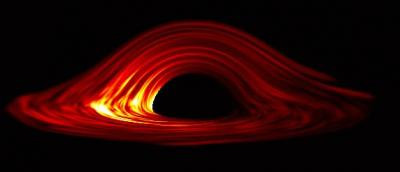Black Holes Are Like Doughnut Holes

Youwouldn't want to eat one, but you might take comfort in the new knowledge thata black hole and its surrounding material take the shape of a doughnut regardless of themass of the black hole itself.
Black holescan't be seen, but astronomers detect them by noting how other objects areaffected by the tremendous gravity created in these smallspheres of space. Intense radiation can be emitted from the areaimmediately surrounding a black hole as incoming material is accelerated to asignificant fraction of light-speed and gets superheated.
"Thisshould be a very messy and complicated environment, but the stuff flowing ontodifferent black holes looks the same, no matter how massive the black holeis," said Barry McKernan, an astrophysicist at the American Museum of Natural History in New York and a professor at the Borough of Manhattan CommunityCollege, City University of New York.
McKernanand colleagues analyzed data collected for 245 activegalactic nuclei, which contain supermassive black holes at their cores.These blackholes feed on infalling gas and can emit powerful radiation beams thatshine with the energy of billions of stars. The black holes studied weighedbetween 1 million and 100 million times the mass of the sun.
Theresearchers specifically measured the X-rays and infrared light around theseblack holes, testing a hypothesis about the relationship between these twotypes of extreme radiation.
They knewthat X-rays should come from hot material close to the black hole, whileinfrared light should come from warm material more distant from the black hole.
This patternallowed the researchers to tell if matter around the black hole was beingobserved face-on (looking directly down onto the black hole ringed by X-raysand infrared light) or edge-on (seeing only the side of the doughnut ofmaterial). Some of the infrared light should also come from part of thedoughnut that has been fried by X-ray bombardment.
Get the Space.com Newsletter
Breaking space news, the latest updates on rocket launches, skywatching events and more!
Bycomparing the proportion of X-rays to infrared light coming from around a blackhole, McKernan and his colleagues indirectly figured out how material may be distributedaround the black hole. After partitioning the data into those observed edge-onand those observed face-on, the team found that 90 percent of the activegalactic nuclei observable face-on had basically the same proportion of X-raysto infrared light.
Theconclusion: No matter the heft of the black hole, its surrounding material tookthe shape of a doughnut with a black hole at its center.
"Nowwe know they all look like doughnuts, and the same kind of doughnut too,"McKernan said. "The lack of variety would disappoint Homer Simpson."
- Video ? Black Hole Diving
- Vote Now: The Strangest Things in Space
- Top 10 Star Mysteries
Join our Space Forums to keep talking space on the latest missions, night sky and more! And if you have a news tip, correction or comment, let us know at: community@space.com.

Space.com is the premier source of space exploration, innovation and astronomy news, chronicling (and celebrating) humanity's ongoing expansion across the final frontier. Originally founded in 1999, Space.com is, and always has been, the passion of writers and editors who are space fans and also trained journalists. Our current news team consists of Editor-in-Chief Tariq Malik; Editor Hanneke Weitering, Senior Space Writer Mike Wall; Senior Writer Meghan Bartels; Senior Writer Chelsea Gohd, Senior Writer Tereza Pultarova and Staff Writer Alexander Cox, focusing on e-commerce. Senior Producer Steve Spaleta oversees our space videos, with Diana Whitcroft as our Social Media Editor.









